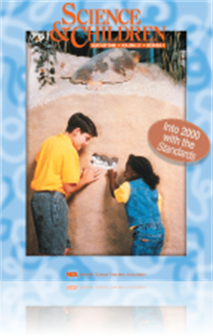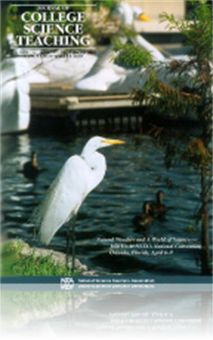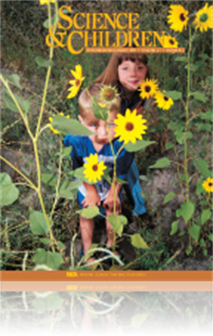All Resources
Journal Article
In general, the way that introductory courses in science are taught leads students to a limited view of science: science as totally objective—as the truth, constructed out of numbers, wires, and laboratory animals by faceless and dimensionless rese...
Journal Article
Student-Centered Seismology Activities
This article describes a three-week unit on earthquakes, a high-interest topic that is no doubt taught in most science classrooms. But in this unit, students learn about earthquakes by building equipment for experiments; using physical models, maps, ...
Journal Article
Fan-powered cars are a great way to explore the concept of motion. The handheld fan allows students to control the force acting on the car, thus eliminating a variable that would arise if students pushed the vehicles by hand. This article describes h...
Journal Article
The New Curriculum Movement in Science
The new science courses differ in purpose from traditional courses and so do the tests. A student is first of all required to understand the facts, formulas, and principles he has learned. Therefore, knowing about science and having the ability to me...
Journal Article
Shrimp Farming in the Classroom
In inquiry-based instruction, discovery and learning belong to the students. In this exploration, jumbo shrimp are the source of inspiration. The magic in this project lies not in successfully culturing these shrimp, known as Macrobrachium rosenbergi...
Journal Article
In this article, the author shares how she developed a unit of study aligned with the Standards that focused on the question “Why do plants have flowers?” The standard that applies to this question is the K–4 Life Science Content Standard C. Pe...
Journal Article
Reaching to the <em>Standards</em>
Sharing inquiry-based teaching ideas with preservice and in-service teachers, other colleagues, and parents will only enhance how science is taught to and perceived by children. With the integration of many subjects, infusion of high-quality literatu...
Journal Article
The Social Responsibilities of Scientists and Science
The following article is based on Dr. Pauling’s address at the annual Convention of the National Science Teachers Association in New York City, April 3. This article was first published in May, 1966....
Journal Article
“Science is About Facts,” or Is It? Changing Student Conceptions About the Nature of Science
This paper analyzes some of the issues in teaching and learning in an introductory physical science course to a group of nonscience majors: elementary teacher education students. In particular, it examines the influence of the course on the students�...
Journal Article
The Case Study: Cooking with Betty Crocker—A Recipe for Case Writing
This column provides original articles on innovations in case study teaching, assessment of the method, as well as case studies with teaching notes. This month’s issue features the general approaches to writing case studies....
Journal Article
This lab exercise investigates and compares the carbon monoxide content of automobile exhaust and cigarette smoke. The experiment uses gas chromatography with thermal conductivity detection to analyze the percentage by volume concentrations found in ...
Journal Article
Incorporating dramatizations into science classes is a useful strategy for demonstrating phenomena that are difficult or impossible to observe directly. The dramatizations are designed to help students learn by translating an abstract concept into an...
Journal Article
This article explains a methodology to successfully implement student multimedia presentations in introductory earth science classes. Students learn to incorporate World Wide Web images, sound, movies, and text into projects using templates, clip art...
Journal Article
SCST: National Standards for Introductory College Science Courses? Can and Should We Develop Them?
In this column the leadership of SCST shares its views with JCST readers. In this month’s issue the author focuses on establishing national standards for college science teaching—can or should we?...
Journal Article
Why Do Students “Cook” Data? A Case Study on the Tenacity of Misconceptions
This paper describes an extraordinary example of data fabrication in which two students and their course instructor are so certain that they know how an experiment should turn out that they repeatedly dismiss contradictory data until they finally rep...
Journal Article
Guest Editorial: To Reweave a Rainbow—Reflections on the Unity of Knowledge
An opinion piece about the "Unity of Knowledge."...
Journal Article
Although Mendeleeff presented his periodic chart in a paper to the German Chemical Society in 1869, its acceptance was a gradual process. The changes in the chart and its movement to its present position inside the front cover of all texts is a perfe...
Journal Article
This exercise visually demonstrates that the binding of calcium to calmodulin changes its conformation to allow binding to a target protein, calcium/calmodulin protein kinase II. It introduces undergraduates to the concept of regulatory pathways cont...
Journal Article
This paper discusses how two different laboratory sections can employ nontraditional investigative laboratory modules that integrate concepts from cell biology, molecular genetics, and chemistry. During each module, students analyze data, draw conclu...
Journal Article
Studies in learning theory indicate that active learning is more effective than passive learning (Matthews, Cooper, Davidson, and Hawkes 1995; McKeachie 1980). Today’s students must be independent thinkers who can function well as team members. Lis...
Journal Article
http://World Wide Weather: Involving students in GLOBE's real-life scientific research
Students at Norwood School and more than 8,000 other schools on seven continents (including Antarctica) learn how scientific research works by participating in the GLOBE program (Global Learning and Observations to Benefit the Environment). Involving...
Journal Article
The scientific and technological issues surrounding environmental problems exemplify why teaching scientific literacy is so vital to environmental science courses. In this paper, the authors analyze some of the strategies that instructors of an envir...
Journal Article
The projects in this article focus on how a team approach can take advantage of the best of the Internet. To spread the word about these projects information is posted on teacher listservs, discussion areas, and Internet clearinghouses for online col...
Journal Article
Only rarely do teaching assistants (TAs) attend professional development workshops designed to acquaint them with pedagogical models. Thus, new instructors typically engage in ineffective instructional methods built on their experiences rather than o...
Journal Article
As we try to achieve the National Science Education Standards (National Research Council, 1996) and promote general science literacy for young children, we might begin by discussing conservation or stewardship. Children can readily understand the ide...
Journal Article
Editor's Note: It <b>Is</b> Exciting
Science and Children’s editor shares thoughts regarding the current issue and introduces NSTA's SciLINKS® connection....
Journal Article
Problem Solver: Teaching Tropisms
Plants are found in most locations in the world and have the remarkable ability to capture and store energy from sunlight. Without the green plant’s ability to carry out the process we call photosynthesis, Earth would be a lifeless, barren planet. ...











